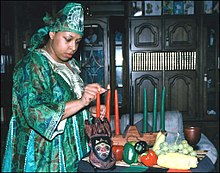Kwanzaa

Kwanzaa is a popular festival among African Americans in the United States and is celebrated from December 26th to January 1st. It was developed by black power activist Maulana Karenga from 1966-67.
content
Kwanzaa is not a religious festival, but a cultural one that contains practical and ideological elements from different African harvest ceremonies. African harvest festivals, other annual festivals and coronation ceremonies are intended to strengthen the cohesion of the social group by establishing a connection to the ancestors in the cosmogonic myth . Kwanzaa was deliberately placed in the time of the Christian Christmas festival in order to oppose the pan-African idea to Christianity, which is made responsible for colonization and slavery.
Origin and development
The festival was developed in 1966 by the American author and activist of the black power civil rights movement Maulana Karenga . The name is a neologism derived from the Swahili word kwanza , which means "first". It should refer to the "first fruits" (Swahili: "matunda ya kwanza"). Karenga chose this East African expression to refer to traditions from West and South African harvest festivals. Kwanzaa has only become better known to the non-black US public in recent years. In addition to Christmas stamps, the American Postal Service has also been offering Kwanzaa stamps since 1997.
procedure
On each of the seven nights of the Kwanzaa celebration, a candle is lit in the candlestick called Kinara: three green, three red and one black, colors that are supposed to represent Africa . Each day has a specific theme: unity, unity ( umoja ), self-determination ( kujichagulia ), group work and responsibility ( ujima ), cooperative economy ( ujamaa ), meaning and purpose ( nia ), creativity ( kumba ) and belief ( imani ).
The seven principles of Kwanzaa (Nguzo Saba)
- Umoja (unity): striving for and maintaining unity in family, community, nation and race.
- Kujichagulia (self-determination): Define yourself and speak for yourself.
- Ujima (cooperation and responsibility): Appropriating and solving the problems of fellow human beings together.
- Ujamaa (Joint Economy): Building and maintaining one's own businesses, shops and companies with joint profit.
- Nia (determination): Set goals for yourself and agree them with the community.
- Kuumba (creativity): To make your church more beautiful and useful than you inherited it.
- Imani (Faith): Believing wholeheartedly in his people, parents, teachers, leaders, righteousness and the victory of their struggle.
literature
- Keith A. Mayes: Kwanzaa. Black Power and the Making of the African-American Holiday Tradition . Routledge, New York 2009, ISBN 978-0-415-99855-0 .
Web links
- The Official Kwanzaa Website, official Kwanzaa website
- African American festivals: Kwanzaa at fest-der-religionen.de
Individual evidence
- ^ Yaw Owusu-Frempong: Afrocentricity, the Adae Festival of the Akan, African American Festivals, and Intergenerational Communication. In: Journal of Black Studies, Volume 35, No. 6, July 2005, pp. 730-750, here pp. 733, 740 (DOI 10.1177 / 0021934704268575).
- ^ Mary Ann French: The Kwanzaa Conundrum. The Washington Post, December 30, 1995
- ↑ Philipp Dorestal: Review of: Mayes, Keith A .: Kwanzaa. Black Power and the Making of the African-American Holiday Tradition. New York 2009. In: H-Soz-u-Kult, February 9, 2010.
